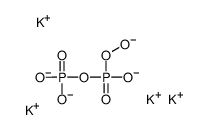tetrapotassium,phosphonatooxy phosphate
Modify Date: 2025-09-11 10:34:06

tetrapotassium,phosphonatooxy phosphate structure
|
Common Name | tetrapotassium,phosphonatooxy phosphate | ||
|---|---|---|---|---|
| CAS Number | 15593-49-4 | Molecular Weight | 346.33600 | |
| Density | N/A | Boiling Point | N/A | |
| Molecular Formula | K4O8P2 | Melting Point | N/A | |
| MSDS | N/A | Flash Point | N/A | |
| Name | tetrapotassium,phosphonatooxy phosphate |
|---|
| Molecular Formula | K4O8P2 |
|---|---|
| Molecular Weight | 346.33600 |
| Exact Mass | 345.76200 |
| PSA | 164.46000 |
| LogP | 0.87280 |
Synonym: Section 2 - COMPOSITION, INFORMATION ON INGREDIENTS
Risk Phrases: 22 8 Section 3 - HAZARDS IDENTIFICATION EMERGENCY OVERVIEW
Harmful if swallowed. Contact with combustible material may cause fire. Potential Health Effects Eye: May cause eye irritation. Skin: May cause skin irritation. May be harmful if absorbed through the skin. Ingestion: Harmful if swallowed. May cause irritation of the digestive tract. Inhalation: May cause respiratory tract irritation. May be harmful if inhaled. Chronic: Not available. Section 4 - FIRST AID MEASURES Eyes: Flush eyes with plenty of water for at least 15 minutes, occasionally lifting the upper and lower eyelids. Get medical aid. Skin: Get medical aid. Flush skin with plenty of water for at least 15 minutes while removing contaminated clothing and shoes. Ingestion: Get medical aid. Wash mouth out with water. Inhalation: Remove from exposure and move to fresh air immediately. If not breathing, give artificial respiration. If breathing is difficult, give oxygen. Get medical aid. Notes to Physician: Section 5 - FIRE FIGHTING MEASURES General Information: As in any fire, wear a self-contained breathing apparatus in pressure-demand, MSHA/NIOSH (approved or equivalent), and full protective gear. Oxidizer. Greatly increases the burning rate of combustible materials. Extinguishing Media: Use water spray, dry chemical, carbon dioxide, or chemical foam. Section 6 - ACCIDENTAL RELEASE MEASURES General Information: Use proper personal protective equipment as indicated in Section 8. Spills/Leaks: Vacuum or sweep up material and place into a suitable disposal container. Section 7 - HANDLING and STORAGE Handling: Avoid breathing dust, vapor, mist, or gas. Avoid contact with skin and eyes. Storage: Do not store near combustible materials. Store in a cool, dry place. Store in a tightly closed container. Section 8 - EXPOSURE CONTROLS, PERSONAL PROTECTION Engineering Controls: Use adequate ventilation to keep airborne concentrations low. Exposure Limits CAS# 15593-49-4: Personal Protective Equipment Eyes: Not available. Skin: Wear appropriate protective gloves to prevent skin exposure. Clothing: Wear appropriate protective clothing to prevent skin exposure. Respirators: Follow the OSHA respirator regulations found in 29 CFR 1910.134 or European Standard EN 149. Use a NIOSH/MSHA or European Standard EN 149 approved respirator if exposure limits are exceeded or if irritation or other symptoms are experienced. Section 9 - PHYSICAL AND CHEMICAL PROPERTIES Physical State: Powder Color: white Odor: odorless pH: Not available. Vapor Pressure: Not available. Viscosity: Not available. Boiling Point: Not available. Freezing/Melting Point: Not available. Autoignition Temperature: Not available. Flash Point: Not available. Explosion Limits, lower: Not available. Explosion Limits, upper: Not available. Decomposition Temperature: Solubility in water: Decomposes. Specific Gravity/Density: Molecular Formula: K4O8P2 Molecular Weight: 346.35 Section 10 - STABILITY AND REACTIVITY Chemical Stability: Not available. Conditions to Avoid: Incompatible materials, excess heat, combustible materials, exposure to moist air or water. Incompatibilities with Other Materials: Reducing agents, acids, bases, finely powdered metals, organic materials, halides, heavy metals. Hazardous Decomposition Products: Carbon monoxide, oxides of phosphorus, carbon dioxide. Hazardous Polymerization: Will not occur. Section 11 - TOXICOLOGICAL INFORMATION RTECS#: CAS# 15593-49-4 unlisted. LD50/LC50: Not available. Carcinogenicity: Potassium peroxydiphosphate - Not listed by ACGIH, IARC, or NTP. Section 12 - ECOLOGICAL INFORMATION Section 13 - DISPOSAL CONSIDERATIONS Dispose of in a manner consistent with federal, state, and local regulations. Section 14 - TRANSPORT INFORMATION IATA No information available. IMO No information available. RID/ADR No information available. Section 15 - REGULATORY INFORMATION European/International Regulations European Labeling in Accordance with EC Directives Hazard Symbols: XN O Risk Phrases: R 22 Harmful if swallowed. R 8 Contact with combustible material may cause fire. Safety Phrases: S 17 Keep away from combustible material. WGK (Water Danger/Protection) CAS# 15593-49-4: No information available. Canada None of the chemicals in this product are listed on the DSL/NDSL list. CAS# 15593-49-4 is not listed on Canada's Ingredient Disclosure List. US FEDERAL TSCA CAS# 15593-49-4 is not listed on the TSCA inventory. It is for research and development use only. SECTION 16 - ADDITIONAL INFORMATION N/A |
| Hazard Codes | O: Oxidizing agent;T: Toxic; |
|---|---|
| Risk Phrases | 8-23/24/25-34 |
| Safety Phrases | 17-26-36/37/39-45 |
| RIDADR | UN 1479 5.1/PG 2 |